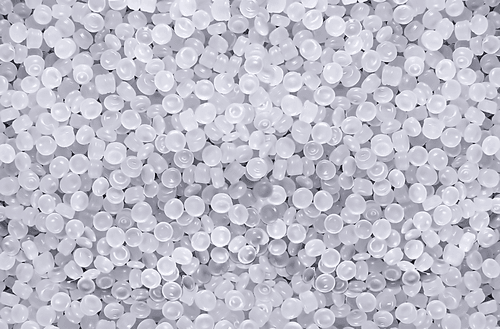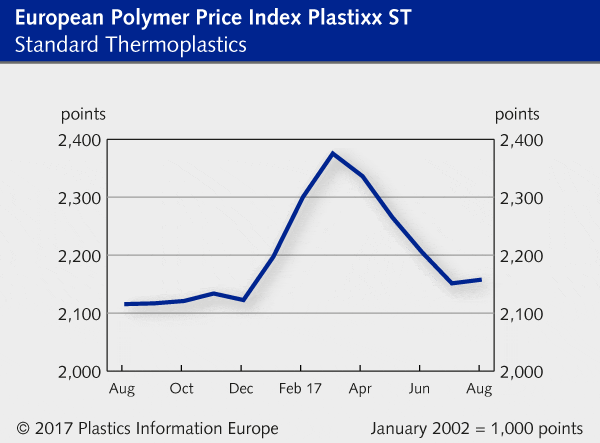
Polymer Price Reports Released for August 2017
The latest polymer price reports and charts have been released by Plastics Information Europe (PIE).
Standard Thermoplastics August 2017: Rollover for polyolefins and PVC / Styrenics oscillate / PET moves upwards / Some significant increases in September / Cost hikes and consequences of Hurricane “Harvey”
PE: In August, most PE producers on the European market failed in their efforts to hike prices. Above all, it was the reluctance by customers to place orders in the classic holiday month that put an end to such endeavours. Price rises and price cuts were, if at all, very small indeed, and a rollover resulted. The pipe grades had some catching-up to do and notations there slipped slightly.
September will see an end to the calm. The early fixing of the ethylene reference price EUR 30/t higher will play only a minor role, though it has set the ball rolling. In the last week of August, the catastrophic storm in the United States paralysed large sections of the petrochemical industry and above all olefins production. Although one or two plants may be able to restart soon, many production lines will remain at a standstill for several weeks. An upward price movement on the global markets is inevitable, but as yet very difficult to quantify. Prices will certainly go up by more than the reference – probably by considerably more.
PP: Rollovers dominated the European PP markets in August. In many regions, trading was slack, although demand was lively in northwestern Europe. Where imports were scarce, producers were able to pull some of the lowest prices up to a level they considered acceptable. The hikes seen for compounds also reflected structural price increases at a major producer.
September threatens to be stormy, with triple-digit price rises potentially on the horizon. One of the determining factors will be the propylene reference contract, which was fixed EUR 40/t higher, but it goes without saying that the devastating hurricane on the US Gulf will also have an important knock-on effect. PIE’s Polyglobe database (www.polyglobe.net) shows that nearly 60% of the entire North American propylene and PP capacities are currently idle. As the outage may well last for several more weeks, especially in the greater Houston area, European producers will be enticed to export more, thus shrinking supply at home.
PVC: At the start of the month, it rapidly became apparent that the few producers who were making demands were only doing so half-heartedly. Peace rapidly ensued, with price increases being put off until September. All the parties were happy with this. For compounds, slight reductions even resulted on account of the lower costs of additives, including modifiers and plasticisers. In September, by contrast, considerable hikes are to be expected over the entire PVC portfolio. The ethylene reference contract has picked up, and the tightening of supplies due to “Harvey” is set to generate considerable upward pressure. At the same time, attractive export windows could open up for European producers in the light of expected supply disruptions worldwide. Rising notations are already evident in Asia.
Styrenics: In August 2017, styrenics have seen only minor price changes, even if the trends were deviating. Prices for PS and ABS were declining after the SM reference contract decreased by EUR 30/t, although suppliers could increase their margins slightly. EPS notations increased marginally because suppliers could take advantage of a tight supply situation.
However, processors have to prepare for a sharp price increase in September: suppliers will transfer most of the latest SM cost increase of EUR 190/t to their customers. In cases where bottlenecks are foreseeable – and EPS figures among them – premiums above the cost increase cannot be ruled out. Premiums on ABS, by contrast, are limited by the marginal increase of other cost components such as butadiene’s rise of EUR 25/t and possibly ACN costs, which will be fixed after editorial deadline. Still, ACN might be influenced by a tightness in the US resulting from the hurricane disaster; prices could therefore make a leap on short call.
PET: The upswing in PET prices in Europe continued into August 2017. Indications that this would be the case with recyclate emerged towards the middle of the month. Widely differing hikes emerged in the primary market, however. Costs had only risen in moderation, and it was instead the market situation resulting from tight supply and brisk demand from a hot holiday month that dictated the pace. Individual starting conditions and alternative options thus assumed greater importance – a state of affairs that generally leads to a greater spread between those involved.
The upward pressure is set to continue in September too, but with a tendency to abate somewhat. It is not possible to predict precisely what impact the hurricane on the US Gulf Coast will have on the cost of paraxylene and MEG. Increases here would doubtless drive up the price of polymers, given that the market is still on the tight side.
Engineering Thermoplastics August 2017: Generally quiet summer month / Stability dominates with traditional materials / Situation with PMMA becomes increasingly dramatic / Upward pressure mounts on a broad front
The European engineering plastics markets experienced a very quiet holiday month in August. Although most delivery times remained long, demand also declined rapidly, creating a massive summer lull. Notations for the majority of traditional engineering polymer materials therefore stagnated. With PMMA, on the other hand, the situation got even worse, as had been expected. Because of bottlenecks with the monomer, the shortage became even more dramatic, so that prices climbed again despite the summer fall in demand. ABS prices fell slightly in line with the feedstocks, while PP compounds underwent a slight upward correction due to structural adjustments.
In September, the upward pressure will increase on a broad front. For PMMA, there will inevitably be further increases. Especially with PA 6.6, price rises are already on the horizon due to growing bottlenecks. Other traditional materials will presumably orientate themselves in the direction of Q4 increases. Here, too, however, the pressure is mounting. ABS will certainly rise with the renewed explosion in the styrene reference price, and hikes are also to be expected with PP compounds.
For more than 34 years, PIE has been an invaluable source of information for European plastics industry decision makers – a quick, yet in-depth look at the development of plastics markets and polymer prices. Available online 24/7 and as a printed newsletter twice a month. To read the entire report, go to www.pieweb.com and sign up for a 48-hour free trial!







